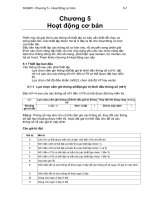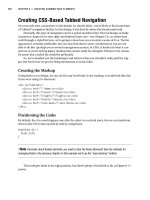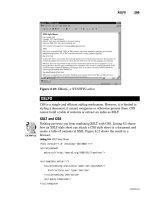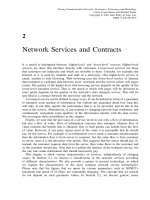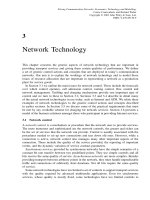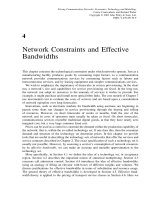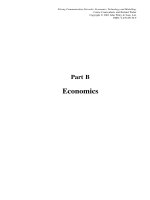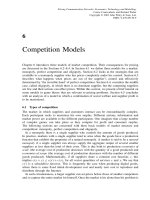Tài liệu Pricing communication networks P5 doc
Bạn đang xem bản rút gọn của tài liệu. Xem và tải ngay bản đầy đủ của tài liệu tại đây (248.59 KB, 29 trang )
Part B
Economics
Pricing Communication Networks: Economics, Technology and Modelling.
Costas Courcoubetis and Richard Weber
Copyright
2003 John Wiley & Sons, Ltd.
ISBN: 0-470-85130-9
5
Basic Concepts
Economics is concerned with the production, sale and purchase of commodities that are in
limited supply, and with how buyers and sellers interact in markets for them. This and the
following chapter provide a tutorial in the economic concepts and models that are relevant to
pricing communications services. It investigates how pricing depends on the assumptions that
we make about the market. For example, we might assume that there is only one sole supplier.
In formulating and analysing a number of models, we see that prices depend on the nature of
competition and regulation, and whether they are driven by competition, the profit-maximizing
aim of a monopoly supplier, or the social welfare maximizing aim of a regulator.
Section 5.1 sets out some basic definitions and describes some factors that affect pricing.
It defines types of markets, and describes three different rationales that can provide guid-
ance in setting prices. Section 5.2 considers the problem of a consumer who faces prices
for a range of services. The key observation is that the consumer will purchase a service up
to an amount where his marginal utility equals the price. Section 5.3 defines the problem
of supplier whose aim is to maximize his profit. Section 5.4 concerns the problem that
is natural for a social planner: that of maximizing the total welfare of all participants in
the market. We relate this to some important notions of market equilibrium and efficiency,
noting that problems can arise if there is market failure due to externalities.
Unfortunately, social welfare is achieved by setting prices equal to marginal cost. Since the
marginal costs of network services can be nearly zero, producers may not be able to cover their
costs unless they receive some additional lump-sum payment. A compromise is to use Ramsey
prices; these are prices which maximize total welfare subject to the constraint that producers
cover their costs. We consider these in Section 5.5. Section 5.6 considers maximizing social
welfare under finite capacity constraints. Section 5.7 discusses how customer demand can be
influenced by the type of network externality that we mentioned in Chapter 1.
The reader of this and the following chapter cannot expect to become an expert in all
economic theory that is relevant to setting prices. However, he will gain an appreciation of
factors that affect pricing decisions and of what pricing can achieve. In later chapters we use
this knowledge to show how one might derive some tariffs for communications services.
5.1 Charging for services
5.1.1 Demand, Supply and Market Mechanisms
Communication services are valuable economic commodities. The prices for which they
can be sold depend on factors of demand, supply and how the market operates. The key
Pricing Communication Networks: Economics, Technology and Modelling.
Costas Courcoubetis and Richard Weber
Copyright
2003 John Wiley & Sons, Ltd.
ISBN: 0-470-85130-9
114 BASIC CONCEPTS
players in the market for communications services are suppliers, consumers, and regulators.
The demand for a service is determined by the value users place upon it and the price they
are willing to pay to obtain it. The quantity of the service that is supplied in the market
depends on how much suppliers can expect to charge for it and on their costs. Their costs
depend upon the efficiency of their network operations. The nature of competition amongst
suppliers, how they interact with customers, and how the market is regulated all have a
bearing on the pricing of network services.
One of the most important factors is competition. Competition is important because
it tends to increases economic efficiency: that is, it increases the aggregate value of the
services that are produced and consumed in the economy. Sometimes competition does not
occur naturally. In that case, regulation by a government agency can increase economic
efficiency. By imposing regulations on the types of tariffs, or on the frequency with which
they may change, a regulator can arrange for there to be a greater aggregate welfare than
if a dominant supplier were allowed to produce services and charge for them however he
likes. Moreover, the regulator can take account of welfare dimensions that suppliers and
customers might be inclined to ignore. For example, a regulator might require that some
essential network services be available to everyone, no matter what their ability to pay.
Or he might require that encrypted communications can be deciphered by law enforcement
authorities. He could take a ‘long term view’, or adopt policies designed to move the market
in a certain desirable direction.
5.1.2 Contexts for Deriving Prices
In Section 1.4.1 we defined the words ‘charge’, ‘tariff’ and ‘price’. We said that a customer
pays charges for network services, and a charge is computed from a tariff . This tariff can
be a complex function and it can take account of various aspects of the service and perhaps
some measurements of the customer’s usage. For example, a telephone service tariff might
be defined in terms of monthly rental, the numbers of calls that are made, their durations,
the times of day at which they are made, and whether they are local or long-distance
calls.
A price is a charge that is associated with one unit of usage. For example, a mobile
phone service provider might operate a two-part tariff of the form a C bx,wherea is a
monthly fixed-charge (or access charge), x is the number of minutes of calling per month,
and b is the price per minute. For a general tariff of the form r .x/,wherex is the amount
consumed, probably a vector, price may depend on x. Given that x is consumed, the price
of one more unit is p D @r.x/=@ x.Ifr.x/ D p
>
x for some price vector p,thenr.x/ is a
linear tariff . All other tariff forms are nonlinear tariffs.
1
For instance, a Cbx is a nonlinear
tariff (price), while bx is a linear tariff (price).
In thinking about how price are determined, there are two important questions to answer:
(a) who sets the price, and (b) with what objective? It is interesting to look at three different
answers and the rationales that they give for thinking about prices. The first answer is that
sometimes the market that sets the price, and the objective is to match supply and demand.
Supply and demand at given prices depend upon the supplier’s technological capacities, the
costs of supply, and the how consumers value the service. If prices are set too low then there
1
In the economics literature, the terminology linear price or uniform price is commonly used instead of a linear
tariff, and nonlinear price instead of a nonlinear tariff. In this case, price refers implicitly to the total amount
paid for the given quantity, i.e. the total charge.
CHARGING FOR SERVICES 115
will be insufficient incentive to supply and there is likely to be unsatisfied demand. If prices
are set too high then suppliers may over-supply the market and find there is insufficient
demand at that price. The ‘correct’ price should be ‘market-clearing’. That is, it should be
the price at which demand exactly equals supply.
A second rationale for setting prices comes about when it is the producer who sets prices
and his objective is to deter potential competitors. Imagine a game in which an incumbent
firm wishes to protect itself against competitors who might enter the market. This game
takes place under certain assumptions about both the incumbent’s and entrants’ production
capabilities and costs. We find that if the firm is to be secure against new entrants seducing
away some of its customers, then the charges that it makes for different services must
satisfy certain constraints. For example, if a firm uses the revenue from selling one product
to subsidize the cost of producing another, then the firm is in danger if a competitor can
produce only the first product and sell it for less. This would lead to a constraint of no
cross-subsidization.
A third rationale for setting prices comes about when a principal uses prices as a
mechanism to induce an agent to take certain actions. The principal cannot dictate directly
the actions he wishes the agent to take, but he can use prices to reward or penalize
the agent for actions that are or are not desired. Let us consider two examples. In our
first example the owner of a communications network is the principal and the network
users are the agents. The principal prices the network services to motivate users to choose
services that both match their needs and avoid wasting network resources. Suppose that
he manages a dial-in modem bank. If he prices each unit of connection time, then he
gives users the incentive to disconnect when they are idle. His pricing is said to be
incentive compatible. That is, it provides an incentive that induces desirable user response.
A charge based only on pricing each byte that is sent would not be incentive compatible
in this way.
In our second example the owner of the communications network is now the agent. A
regulator takes the role of principal and uses price regulation to induce the network owner
to improve his infrastructure, increase his efficiency, and provide the services that are of
value to consumers.
These are three possible rationales for setting prices. They do not necessarily lead to the
same prices. We must live with the fact that there is no single recipe for setting prices that
takes precedence over all others. Pricing can depend on the underlying context, or contexts,
and on contradictory factors. This means that the practical task of pricing is as much an art
as a science. It requires a good understanding of the particular circumstances and intricacies
of the market.
It is not straightforward even to define the cost of a good. For example, there are many
different approaches to defining the cost of a telephone handset. It could be the cost of the
handset when it was purchased (the historical cost), or its opportunity cost (the value of what
we must give up to produce it), or the cost of the replacing it with a handset that has the
same features (its modern equivalent asset cost). Although, in this chapter, we assume that
the notion of the cost is unambiguously defined, we return to the issue of cost definition in
Chapter 7.
In this chapter we review the basic economic concepts that are needed to understand
various contexts for defining prices. We focus on defining the various economic agents that
interact in a marketplace. In the following chapter we analyze various competition scenarios.
We begin by considering the problem that a consumer faces when he must decide how much
of each of a number of services to purchase.
116 BASIC CONCEPTS
5.2 The consumer’s problem
5.2.1 Maximization of Consumer Surplus
Consider a market in which n customers can buy k services. Denote the set of customers
by N Df1;:::;ng.Customeri can buy a vector quantity of services x D .x
1
;:::;x
k
/ for
a payment of p.x /. Let us suppose that p.x/ D p
>
x D
P
j
p
j
x
j
, for a given vector of
prices p D . p
1
;:::;p
k
/. Assume that the available amounts of the k services are unlimited
and that customer i seeks to solve the problem
x
i
. p/ D arg max
x
h
u
i
.x/ p
>
x
i
(5.1)
Here u
i
.x/ is the utility to customer i of having the vector quantities of services x.One
can think of u
i
.x/ as the amount of money he is willing to pay to receive the bundle that
consists of these services in quantities x
1
:::;x
k
.
It is usual to assume that u
i
.Ð/ is strictly increasing and strictly concave for all i.This
ensures that there is a unique maximizer in (5.1) and that demand decreases with price.
If, moreover, u.Ð/ is differentiable, then the marginal utility of service j,asgivenby
@u
i
.x/=@x
j
, is a decreasing function of x
j
. We make these assumptions unless we state
otherwise. However, we note that there are cases in which concavity does not hold. For
example, certain video coding technologies can operate only when the rate of the video
stream is above a certain minimum, say x
Ł
, of a few megabits per second. A user who
wishes to use such a video service will have a utility that is zero for a rate x that is less
than x
Ł
and positive for x at x
Ł
. This is a step function and not concave. The utility may
increase as x increases above x
Ł
, since the quality of the displayed video increases with
the rate of the encoding. This part of the utility function may be concave, but the utility
function as a whole is not. In practice, for coding schemes like MPEG, the utility function
is not precisely a step function, but it resembles one. It starts at zero and increases slowly
until a certain bit rate is attained. After this point it increases rapidly, until it eventually
reaches a maximum value. The first part of the curve captures the fact that the coding
scheme cannot work properly unless a certain bit rate is available.
The expression that is maximized on the right-hand side of (5.1) is called the consumer’s
net benefit or consumer surplus,
CS
i
D max
x
h
u
i
.x/ p
>
x
i
It represents the net value the consumer obtains as the utility of x minus the amount paid
for x. The above relations are summarized in Figure 5.1.
The vector x
i
. p/ is called the demand function for customer i . It gives the quantities
x
i
D .x
i
1
;:::;x
i
k
/ of services that customer i will buy if the price vector is p.Theaggregate
demand function is x. p/ D
P
i2N
x
i
. p/; this adds up the total demand of all the users at
prices p. Similarly, the inverse aggregate demand function, p.x/, is the vector of prices at
which the total demand is x.
Consider the case of a single customer who is choosing the quantity to purchase of just
a single service, say service j. Imagine that the quantities of all other services are held
constant and provided to the customer for no charge. If his utility function u.Ð/ is concave
and twice differentiable in x
j
then his net benefit, of u.x/ p
j
x
j
, is maximized where it is
stationary point with respect to x
j
,/=@x
j
D p
j
. At this point, the marginal
increase in utility due to increasing x
j
is equal to the price of j. We also see that the
customer’s inverse demand function is simply p
j
.x
j
/ D @u.x/=@ x
j
. It is the price at which
THE CONSUMER’S PROBLEM 117
utility u(x)
x
px
x(p)
= max[u(x) − px]
maximized net benefit
0
Figure 5.1 The consumer has a utility u.x/ for a quantity x of a service. In this figure, u.x / is
increasing and concave. Given the price vector p, the consumer chooses to purchase the amount
x D x. p/ that maximizes his net benefit (or consumer surplus). Note that at x D x. p/ we have
@u.x/=@ x D p.
x(p)
x
u′(x)
CS(p)
p
px
$
0
Figure 5.2 The demand curve for the case of a single customer and a single good. The derivative
of u.x /, denoted u
0
.x /, is downward sloping, here for simplicity shown as a straight line. The area
under u
0
.x / between 0 and x. p/ is u.x . p//, and so subtracting px (the area of the shaded
rectangle) gives the consumer surplus as the area of the shaded triangle.
he will purchase a quantity x
j
. Thus, for a single customer who purchases a single service
j, we can express his consumer surplus at price p
j
as
CS. p
j
/ D
Z
x
j
. p
j
/
0
p
j
.x/ dx p
j
x
j
. p
j
/ (5.2)
We illustrate this in Figure 5.2 (dropping the subscript j).
We make a final observation about (5.1). We have implicitly assumed that the (per unit)
prices charged in the market are the same for all units purchased by the customer. There are
more general pricing mechanisms in which the charge paid by the customer for purchasing
a quantity x is a more general function r.x/, not of the form p
>
x. For instance, prices may
depend on the total amount bought by a customer, as part of nonlinear tariffs, of the sort
we examine in Section 6.2.2. Unless explicitly stated, we use the term ‘price’ to refer to
the price that defines a linear tariff p
>
x.
The reader may also wonder how general is (5.1) in expressing the net benefit of the
customer as a difference between utility and payment. Indeed, a more general version is
as follows. A customer has a utility function v.x
0
; x/,wherex
0
is his net income (say in
dollars), and x is the vector of goods he consumes. Then at price p he solves the problem
x
i
. p/ D arg
n
max
x
v.x
0
p
>
x; x/ : p
>
x Ä x
0
o
118 BASIC CONCEPTS
In the simple case that the customer has a quasilinear utility function, of the form
v.x
0
; x/ D x
0
C u.x/, and assuming his income is large enough that x
0
p
>
x > 0at
the optimum, he must solve a problem that is equivalent to (5.1). It is valid to assume a
quasilinear utility function when the customer’s demand for services is not very sensitive
to his income, i.e. expenditure is a small proportion of his total income, and this is the
case for most known communications services. In our economic modelling, we use these
assumptions regarding utility functions since they are reasonable and simplify significantly
the mathematical formulas without reducing the qualitative applicability of the results.
5.2.2 Elasticity
Concavity of u.Ð/ ensures that both x. p/ and p.x/ are decreasing in their arguments, or
as economists say, downward sloping. As price increases, demand decreases. A measure
of this is given by the price elasticity of demand.Customeri has elasticity of demand for
service j given by
ž
j
D
@x
j
. p/=@p
j
x
j
= p
j
where, for simplicity, we omit the superscript i in the demand vector x
i
, since we refer to
a single customer. Thus
1x
j
x
j
D ž
j
1p
j
p
j
and elasticity measures the percentage change in the demand for a good per percentage
change in its price. Recall that the inverse demand function satisfies p
j
.x/ D @u.x/=@x
j
.
So the concavity of the utility function implies @p
j
.x/=@x
j
Ä 0andž
j
is negative.
2
As
jž
j
j is greater or less than 1 we say that demand of customer i for service j is respectively
elastic or inelastic. Note that since we are working in percentages, ž
j
does not depend
upon the units in which x
j
or p
j
is measured. However, it does depend on the price, so
we must speak of the ‘elasticity at price p
j
. The only demand function for which elasticity
is the same at all prices is one of the form x. p/ D ap
ž
. One can define other measures
of elasticity, such ‘income elasticity of demand’, which measures the responsiveness of
demand to a change in a consumer’s income.
5.2.3 Cross Elasticities, Substitutes and Complements
Sometimes, the demand for one good can depend on the prices of other goods. We define
the cross elasticity of demand , ž
jk
, as the percentage change in the demand for good j per
percentage change in the price of another good, k. Thus
ž
jk
D
@x
j
. p/=@p
k
x
j
= p
k
and
1x
j
x
j
D ž
jk
1p
k
p
k
2
Authors disagree in the definition of elasticity. Some define it as the negative of what we have, so that it comes
out positive. This is no problem provided one is consistent.
THE SUPPLIER’S PROBLEM 119
But why should the price of good k influence the demand for good j? The answer is
that goods can be either substitutes or complements. Take, for example, two services of
different quality such as VBR and ABR in ATM. If the price for VBR increases, then
some customers who were using VBR services, and who do not greatly value the higher
quality of VBR over ABR, will switch to ABR services. Thus, the demand for ABR will
increase. The services are said to be substitutes. The case of complements is exemplified
by network video transport services and video conferencing software. If the price of one
of these decreases, then demand for both increases, since both are needed to provide the
complete video conferencing service.
Formally, services j and k are substitutes if @x
j
. p/=@p
k
> 0 and complements if
@x
j
. p/=@p
k
< 0. If @x
j
. p/=@p
k
D 0, the services are said to be independent. Surprisingly,
the order of the indices j and k is not significant. To see this, recall that the inverse
demand function satisfies p
j
.x/ D @u.x/=@ x
j
. Hence @p
j
.x/=@x
k
D @p
k
.x/=@x
j
,andso
the demand functions satisfy
@x
j
. p/
@p
k
D
@x
k
. p/
@p
j
5.3 The supplier’s problem
Suppose that a supplier produces quantities of k different services. Denote by y D
.y
1
;:::;y
k
/ the vector of quantities of these services. For a given network and operating
method the supplier is restricted to choosing y within some set, say Y , usually called the
technology set or production possibilities set in the economics literature. In the case of
networks, this set corresponds to the acceptance region that is defined in Chapter 4.
Profit,orproducer surplus, is the difference between the revenue that is obtained from
selling these services, say r.y/, and the cost of production, say c.y/. An independent firm
having the objective of profit maximization, seeks to solve the problem of maximizing
the profit,
³ D max
y2Y
ð
r.y/ c.y/
Ł
An important simplification of the problem takes place in the case of linear prices,when
r.y/ D p
>
y for some price vector p. Then the profit is simply a function of p,say³.p/,
as is also the optimizing y,sayy.p/.Herey. p/ is called the supply function, since it gives
the quantities of the various services that the supplier will produce if the prices at which
they can be sold is p.
The way in which prices are determined depends upon the prevailing market mechanism.
We can distinguish three important cases. The nature of competition in these three cases
is the subject of Chapter 6. If the supplier is a monopolist, i.e. the sole supplier in an
unregulated monopoly, then he is free to set whatever prices he wants. His choice is
constrained only by the fact that as he increases the prices of services the customers are
likely to buy less of them.
If the supplier is a small player amongst many then he may have no control over p.We
say he is a price taker. His only freedom is in choice of y. This is a common scenario in
practice. In such a scenario, the supplier sells at given linear prices, which are independent
of the quantities sold. This is also the case for a regulated monopoly, in which the price
vector p is fixed by the regulator, and the supplier simply supplies the services that the
market demands at the given price p.
120 BASIC CONCEPTS
A middle case, in which a supplier has partial influence over p,iswhenheisin
competition with just a few others. In such an economy, or so-called oligopoly, suppliers
compete for customers through their choices of p and y. This assumes that suppliers do
not collude or form a cartel. They compete against one another and the market prices of
services emerge as the solution to some noncooperative game.
5.4 Welfare maximization
Social welfare (which is also called social surplus) is defined as the sum of all users’
net benefits, i.e. the sum of all consumer and producer surpluses. Note that weighted
sums of consumer and producer surpluses can be considered, reflecting the reality that a
social planner/regulator/politician may attach more weight to one sector of the economy
than to another. We speak interchangeably of the goals of social welfare maximization,
social surplus maximization, and ‘economic efficiency’. The key idea is that, under certain
assumptions about the concavity and convexity of utility and cost functions, the social
welfare can be maximized by setting an appropriate price and then allowing producers and
consumers to choose their optimal levels of production and consumption. This has the great
advantage of maximizing social welfare in a decentralized way.
We begin by supposing that the social welfare maximizing prices are set by a supervising
authority, such as a regulator of the market. Suppliers and consumers see these prices and
then optimally choose their levels of production and demand. They do this on the basis of
information they know. A supplier sets his level of production knowing only his own cost
function, not the consumers’ utility functions. A consumer sets his level of demand knowing
only his own utility function, not the producers’ cost functions or other customers’ utility
functions. Individual consumer’s utility functions are private information, but aggregate
demand is commonly known.
Later we discuss perfectly competitive markets, i.e., a markets in which no individual
consumer or producer is powerful enough to control prices, and so all participants must be
price takers. It is often the case that once prices settle to values at which demand matches
supply, the social welfare is maximized. Thus a perfectly competitive market can sometimes
need no regulatory intervention. This is not true, however, if there is some form of market
failure, such as that caused by externalities. In Section 5.7 we see, for example, how a
market with strong network externality effects may remain small and never actually reach
the socially desirable point of large penetration.
In the remainder of this section, we address the problem faced by a social planner who
wishes to maximize social welfare. In Sections 5.4.1 and 5.4.2 we show that he can often
do this by setting prices. Section 5.4.3 looks at the assumptions under which this is true
and what can happen if they do not hold. Section 5.4.4 works through a specific example,
that of peak load pricing. Sections 5.4.5 and 5.4.6 are concerned with how the planner’s
aim can be achieved by market mechanisms and the sense in which a market can naturally
find an efficient equilibrium. Social welfare is maximized by marginal cost pricing, which
we discuss in Section 5.4.7.
5.4.1 The Case of Producer and Consumers
We begin by modelling the problem of the social planner who by regulation can dictate the
levels of production and demand so as to maximize social welfare. Suppose there is one
producer, and a set of consumers, N Df1;:::;ng.Letx
i
denote the vector of quantities
WELFARE MAXIMIZATION 121
of k services consumed by consumer i.Letx D x
1
CÐÐÐC x
n
denote the total demand,
and let c.x/ denote the producer’s cost to produce x. The social welfare (or surplus), S,is
the total utility of the services consumed minus their cost of production, and so is written
S D
X
i2N
u
i
.x
i
/ c.x/
Since the social planner takes an overall view of network welfare, let us label his problem
as
SYSTEM : maximize
x;x
1
;:::;x
n
X
i2N
u
i
.x
i
/ c.x/; subject to x D x
1
CÐÐÐCx
n
Assume that each u
i
.Ð/ is concave and c.Ð/ is convex.
3
Then SYSTEM can be solved by
use of a Lagrange multiplier p on the constraint x D x
1
CÐÐÐCx
n
. That is, for the right
value of p, the solution can be found by maximizing the Lagrangian
L D
X
i2N
u
i
.x
i
/ c.x/ C p
>
.x x
1
ÐÐÐx
n
/
freely over x
1
;:::;x
n
and x. Now we can write
L D CS C ³ (5.3)
where
CS D
X
i2N
h
u
i
.x
i
/ p
>
x
i
i
and ³ D p
>
x c.x/
In (5.3) we have written L as the sum of two terms, each of which is maximized over
different variables. Hence, for the appropriate value of the Lagrange multiplier p (also
called a dual variable), L is maximized by maximizing each of the terms individually. The
first term is the aggregate consumers’ surplus, CS. Following the previous observation, the
consumers are individually posed the set of problems
CONSUMER
i
: maximize
x
i
h
u
i
.x
i
/ p
>
x
i
i
; i D 1;:::;n (5.4)
The second term is the producer’s profit, ³ . The producer is posed the problem
PRODUCER : maximize
x
h
p
>
x c.x/
i
(5.5)
Thus, we have the remarkable result that the social planner can maximize social surplus
by setting an appropriate price vector p. In practice, it can be easier for him to control the
dual variable p, rather than to control the primal variables x; x
1
;:::;x
n
directly.
This price controls both production and consumption. Against this price vector, the
consumers maximize their surpluses and the producer maximizes his profit. Moreover,
3
This is typically the case when the production facility cannot be expanded in the time frame of reference, and
marginal cost of production increases due to congestion effects in the facility. In practice, the cost function may
initially be concave, due to economies of scale, and eventually become convex due to congestion. In this case,
we imagine that the cost function is convex for the output levels of interest.
122 BASIC CONCEPTS
u(x) − c(x)
c(x)
u′
c′
p
$
x(p)
Figure 5.3 A simple illustration of the social welfare maximization problem for a single good.
The maximum is achieved at the point where the customer’s aggregate demand curve u
0
intersects
the marginal cost curve c
0
.
from (5.4)–(5.5) we see that provided the optimum occurs for 0 < x
i
j
< 1,thisprice
vector satisfies
@u
i
.x
i
/
@x
i
j
D
@c.x/
@x
j
D p
j
:
That is, prices equal the supplier’s marginal cost and each consumer’s marginal utility at
the solution point. We call these prices marginal cost prices. A graphical interpretation of
the optimality condition is shown in Figure 5.3.
We have called the problem of maximizing social surplus the SYSTEM problem and have
seen that price is the catalyst for solving it, through decentralized solution of PRODUCER
and CONSUMER
i
problems. The social planner, or regulator, sets the price vector p.Once
he has posted p the producer and each consumer maximizes his own net benefit (of supplier
profit or consumer surplus). The producer automatically supplies x if he believes he can
sell this quantity at price p. He maximizes his profit by taking x such that for all j, either
p
j
D @c.x/=@ x
j
,orx
j
D 0if p
j
D 0. The social planner need only regulate the price;
the price provides a control mechanism that simultaneously optimizes both the demand and
level of production. We have assumed in the above that the planner attaches equal weight
to consumer and producer surpluses. In this case, the amount paid by the consumers to the
producer is a purely internal matter in the economy, which has no effect upon the resulting
social surplus.
The same result holds if there is a set M of producers, the output of which is controlled
by the social planner to meet an aggregate demand at minimum total cost. Using the same
arguments as in the case of a single producer, the maximum of
S D
X
i2N
u
i
.x
i
/
X
j2M
c
j
.y
j
/
subject to
P
i2N
x
i
D
P
j2M
y
j
, is achieved by
p
h
D @u
i
.x
i
/=@x
i
h
D @c
j
.y
j
/=@y
j
h
; for all h; i; j (5.6)
In other words, consumers behave as previously, and every supplier produces an output
quantity at which his marginal cost vector is p.
Iterative price adjustment: network and user interaction
How might the social planner find the prices at which social welfare is maximized? One
method is to solve (5.6), if the utilities and the cost functions of the consumers and the
